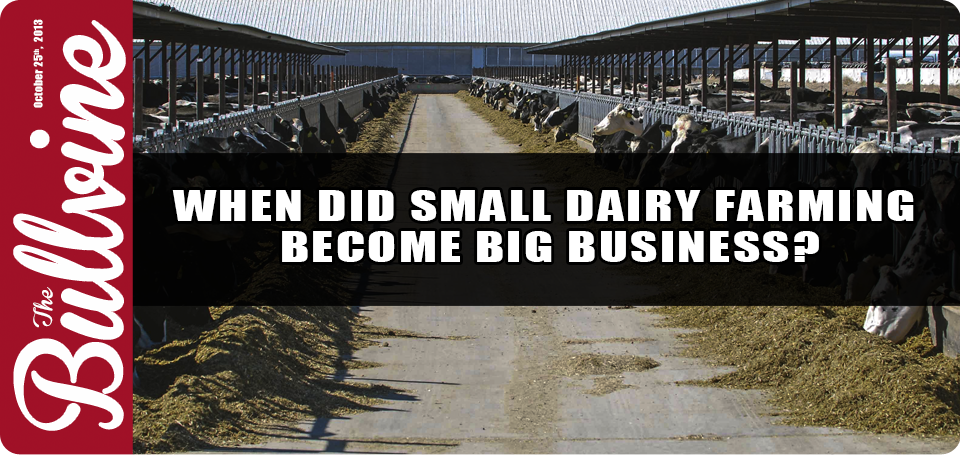I cannot tell you the number of times that I have heard dairy farmers from many countries refer to dairy farming as a way of life. But more and more I am noticing a transition from dairying being about the way of life and becoming a discussion focused on strategic business planning. This shift from “How do we live?” to “How are we profitable?” has forced many to decide to leave the industry.
 The US Situation
The US Situation
The US dairy industry and agriculture industry has faced the problem of overproduction for the past 100 years. Improvements in equipment and machinery, better genetics, better feed, have made US dairy farmers more successful at what they do. Well, successful at everything except for making money. And while many dairy operators support trying to keep overall production lower in order to increase prices, none have been willing to cap their own production in order to do so.
Just as small industrial enterprises might seek to boost profits by becoming bigger and more efficient, American dairy farmers for the most part have gotten larger and larger and consolidated their operations to become more efficient and increase margins. Let’s look at the facts. They tell you that the average herd size in the US is currently 115 cows and that 74% of dairy farms have fewer than 100 cows. But the key stat to take not of is that farms with more than 100 cows produce 85 percent of the milk. This means that a mere 26% of the producers account for the majority of the milk production in the US.
Furthermore, today’s larger operations are not typically the family run operations that we usually associate with “The way of life” phrase that we all love to pass around. While, there are exceptions, many large dairy herd operations are more often owned by huge conglomerates, multinational firms or absentee stockholders. In 1900, half of the labor force were farmers, but by the end of the century only 2 percent worked on farms. Nearly 60 percent of the farmers at the end of the century worked only part-time on farms; they held other, non-farm jobs to supplement their farm income. Today, only about 6 percent of all farmers are under the age of 35. The high cost of capital investment — in land and equipment — makes entry into full-time farming extremely difficult for most potential farmers
Sadly, less than 25 percent of all farms in America bring in gross revenues in excess of $50,000. It has been estimated that living expenses for the average farm family in the US exceed $47,000 per year. Clearly, many farms that meet the U.S. Census’ definition would not produce sufficient income to meet farm family living expenses. In fact, fewer than 1 in 4 of the farms can cover living expenses. As a result between 1970 and today the United States has lost 88 percent of its dairy farms.
As these numbers demonstrate, the American “family farm”, rooted firmly in the nation’s history and celebrated in the myth of the sturdy yeoman, faces powerful economic challenges. Urban and suburban Americans continue to rhapsodize about the neat barns and cultivated fields of the traditional rural landscape, but it remains uncertain whether they are willing to pay the price — either in higher food prices or government subsidies to farmers — of preserving the family farm in such a picturesque form.
 The Canadian Story
The Canadian Story
In Canada the story is a little different. Supply management has helped control the overall milk price so that smaller dairy farmers can be profitable enough to support the “way of life” that everyone dreams about. But there are other challenges that have come with supply management. The cost of entry is so high that it is an impossible hurdle for many of the next generation.
It’s a situation we have all experienced in our own families. The next generation has worked years on the family farm, while the spouse has worked part time off the farm as well as the done the majority of the work raising the children. In many case, the challenge is they did not build up enough equity/capital in order for a bank to be willing to loan them the millions of dollars needed to purchase the farm and the quota. As a result the multi-generational family farm has is sold, and the dairy industry loses another passionate young breeder due to economic circumstances.
Sure a good farm succession plan would have helped (Read more: Farm Succession: Which Exit Is Yours? And Farm Succession: Kicking the Hornet’s Nest?). However, most young people these days are not too eager to choose dairy farming as a career. A lot of young adults that grew up on family dairy farms have decided that investing millions of dollars in a business that requires you to work 12 hours or more per day most of the year for very meager wages is simply not worth it.
The Bullvine Bottom Line
There is no question that the face of dairy farming and agriculture as a whole is changing. While a small few (in relation to production) still work at trying to preserve the “family farm”, dairy farming as a whole has become big business focused on margins and sustainability. In order to compete with these corporate farms, many farm families need to run their operations more as a business than a way of life. (Read more: What’s the Plan?) If they don’t, they will go the way of the dodo bird. Nothing more than a vague memory from the past.
Get original “Bullvine” content sent straight to your email inbox for free.








 The US Situation
The US Situation The Canadian Story
The Canadian Story










Leave a Reply
You must be logged in to post a comment.